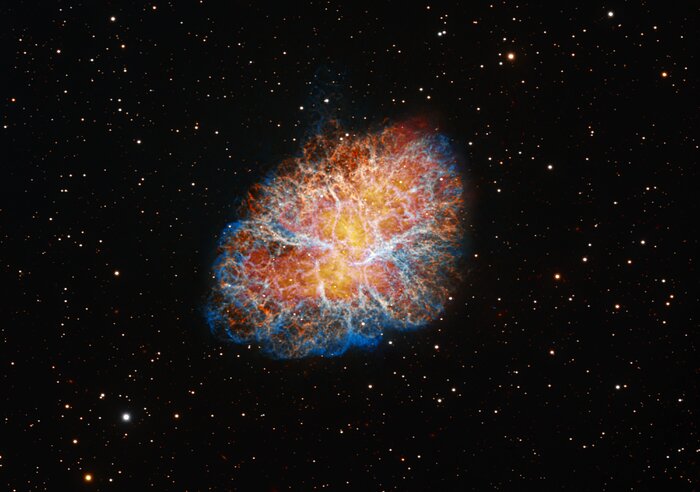A legendary nebula
The nebula that keeps on giving, Messier 1 (Crab Nebula) is captured here by the Nicholas U. Mayall 4-meter Telescope from Kitt Peak National Observatory (KPNO), a Program of NSF’s NOIRLab. The storied history of this supernova remnant in modern astronomy begins when it was recorded in 1731 by British astronomer John Bevis, who believed it was nothing more than a cloudy blob. It was more than three decades later that French comet hunter Charles Messier clarified that the object was in fact something, and it became the first entry in his catalog of nebulae and star clusters. Then in the early 20th century astronomers connected Messier 1 to a supernova explosion observed by Chinese astronomers in 1054. This made the Crab Nebula the first astronomical object to be connected to a previously observed supernova.
A pulsar — the ultra-dense, rapidly spinning remnant of a star — inside the Crab Nebula was discovered in 1968 at radio wavelengths. Its presence in the optical part of the spectrum was confirmed a year later by Americans John Cocke and Donald Taylor and British astronomer Michael Disney using the UArizona 0.9-meter Spacewatch Telescope at KPNO. The Crab Pulsar then became integral in advancing scientific understanding of supernova remnants: it was the first of its kind to link a historical supernova to a pulsar whose precise age is known.
This image was the last taken with the Mayall telescope before the Dark Energy Spectroscopic Instrument (DESI) was installed. The Crab Nebula was also the first target for the telescope’s first light in 1973.
Credit:KPNO/NOIRLab/NSF/AURA
About the Image
| Id: | iotw2311a |
| Type: | Observation |
| Release date: | March 15, 2023, noon |
| Size: | 4017 x 2825 px |
About the Object
| Name: | M1, NGC 1952 |
| Distance: | 6500 light years |
| Constellation: | Taurus |
| Category: | Nebulae |
Image Formats
Wallpapers
Coordinates
| Position (RA): | 5 34 31.43 |
| Position (Dec): | 22° 0' 49.71" |
| Field of view: | 16.74 x 11.77 arcminutes |
| Orientation: | North is 0.2° left of vertical |
Colors & filters
| Band | Wave-length | Tele-scope |
|---|---|---|
| Optical OIII | 502 nm | Nicholas U. Mayall 4-meter Telescope Mosaic-3 |
| Optical H-alpha | 657 nm | Nicholas U. Mayall 4-meter Telescope Mosaic-3 |
| Optical i | 772 nm | Nicholas U. Mayall 4-meter Telescope Mosaic-3 |

